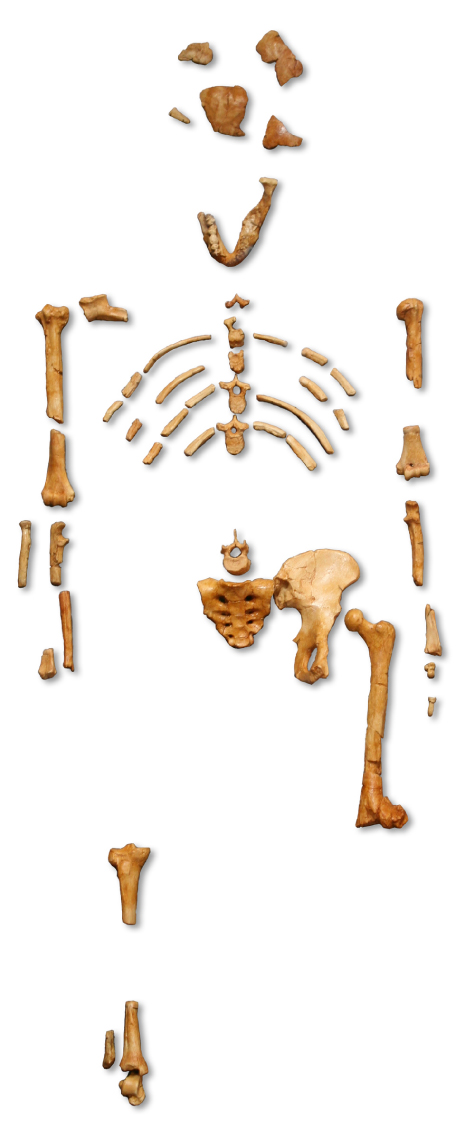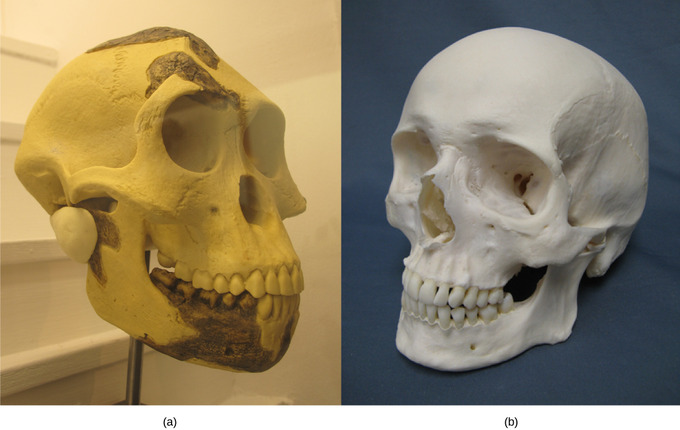29.7C: Early Hominins
- Page ID
- 13943
The hominin Australopithecus evolved 4 million years ago and is believed to be in the ancestral line of the genus Homo.
- Describe the physical characteristics of the Australopiths and compare them to those of modern humans
Key Points
- The early hominin Australopithecus displayed various characteristics which show more similarity to the great apes than to modern humans: great sexual dimorphism, small brain size in comparison to body mass, larger canines and molars, and a prognathic jaw.
- Australopithecus africanus lived between 2 and 3 million years ago and had a larger brain than A. afarensis, but was still less than one-third the size of the modern human brain.
- The gracile australopiths had a relatively slender build and teeth that were suited for soft food and may have had a partially carnivorous diet, while the robust australopiths probably ate tough vegetation.
Key Terms
- dentition: the type, number and arrangement of the normal teeth of an organism or of the actual teeth of an individual
- sexual dimorphism: a physical difference between male and female individuals of the same species
- bipedalism: the habit of standing and walking on two feet
Early Hominins: Genus Australopithecus
Australopithecus (“southern ape”) is a genus of hominin that evolved in eastern Africa approximately 4 million years ago and became extinct about 2 million years ago. This genus is of particular interest to us as it is thought that our genus, genus Homo, evolved from Australopithecus about 2 million years ago. Australopithecus had a number of characteristics that were more similar to the great apes than to modern humans. For example, sexual dimorphism was more exaggerated than in modern humans. Males were up to 50 percent larger than females, a ratio that is similar to that seen in modern gorillas and orangutans. In contrast, modern human males are approximately 15 to 20 percent larger than females. The brain size of Australopithecus relative to its body mass was also smaller than modern humans and more similar (although larger) to that seen in the great apes. A key feature that Australopithecus had in common with modern humans was bipedalism, although it is likely that Australopithecus also spent time in trees. Hominin footprints, similar to those of modern humans, found in Laetoli, Tanzania, are dated to 3.6 million years ago. They show that hominins at the time of Australopithecus were walking upright.
There were a number of Australopithecus species, often referred to as australopiths. Australopithecus anamensis lived about 4.2 million years ago. More is known about another early species, Australopithecus afarensis, which lived between 3.9 and 2.9 million years ago. This species demonstrates a trend in human evolution: the reduction of the dentition and jaw in size. A. afarensis had smaller canines and molars compared to apes, but these were larger than those of modern humans. Its brain size was 380–450 cubic centimeters, approximately the size of a modern chimpanzee brain. It also had prognathic jaws, which is a relatively longer jaw than that of modern humans. In the mid-1970s, the fossil of an adult female A. afarensis was found in the Afar region of Ethiopia, dated to 3.24 million years ago. The fossil, which is informally called “Lucy,” is significant because it was the most complete australopith fossil found, with 40 percent of the skeleton recovered.


Australopithecus africanus lived between 2 and 3 million years ago. It had a slender build and was bipedal, but had robust arm bones and, as with other early hominids, may have spent significant time in trees. Its brain was larger than that of A. afarensis at 500 cubic centimeters, which is slightly less than one-third the size of modern human brains. Two other species, Australopithecus bahrelghazaliand Australopithecus garhi, have been added to the roster of australopiths in recent years.
A Dead End
While most australopiths had a relatively slender, gracile build and teeth suited for soft food, there were also australopiths of a more robust build, dating to approximately 2.5 million years ago. These hominids were larger and had large grinding teeth. Their molars show heavy wear, suggesting that they had a coarse and fibrous vegetarian diet as opposed to the partially carnivorous diet of the more gracile australopiths. They include Australopithecus robustus of South Africa, and Australopithecus aethiopicus and Australopithecus boisei of East Africa. These hominids became extinct more than 1 million years ago and are not thought to be ancestral to modern humans, but rather members of an evolutionary branch on the hominin tree that left no descendants.


